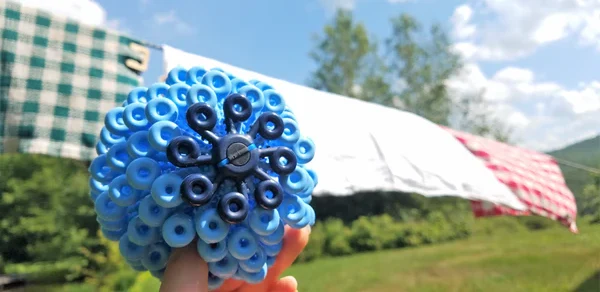Microplastics are tiny plastic pieces, and they’re a big problem. They’re everywhere – from high mountains to deep oceans, and even inside animals and humans. The most common type is microfibers, which are like tiny threads. They mostly come from synthetic clothes that shed them.
When we wash these clothes, millions of microfibers are released. How many fibers come off depends on the type of fabric, how the washing machine works, what kind of soap we use, the water temperature, and how long the wash is.
These fibers go from our washing machines into wastewater, and then to treatment plants. Even the best plants can’t catch all the fibers – so lots still end up in rivers, lakes, and oceans.
The fibers that get caught in treatment plants mix with solid waste, turning into sewage sludge. When this sludge is used as fertilizer, the microfibers get into the soil and air. They can end up in plants and animals, climbing up the food chain.
In water, these microplastics are eaten by fish and other sea creatures. They can mess up their health, growth, and behavior. Microplastics aren’t just plastic; they have harmful chemicals like phthalates and bisphenol A. These can leak out and might affect our hormones.
Textile microfibers also have extra chemicals, like dyes, wrinkle-fighters, and flame retardants. These fibers can pick up other bad stuff in the water, like metals and pesticides. This makes them even more dangerous for the animals that eat them.
Laundry is one of the top sources of microplastic pollution!
How To Wash Your Clothes More Sustainably
Washing our clothes more sustainably is key to reducing microfiber pollution. Different fabrics shed at various rates. For instance, fluffy or fuzzy fabrics like fleece let go of more microfibers compared to tightly woven ones. Even natural fibers, like cotton and wool, shed microfibers that can grab pollutants.
Textile experts and companies are working on new fabrics that shed less. They’re using longer fibers and special coatings to cut down on shedding. But you don’t have to wait for these innovations. There are simple things you can do now:
- Wash clothes less often. Full loads instead of smaller ones mean less friction and fewer microfibers.
- Choose cold water for washing. It releases fewer microfibers than hot water.
- Cut down on detergent, which can increase microfiber release.
- Go for a front-loading washing machine. Its tumbling action is gentler and releases fewer microfibers.
There are also products that catch microfibers in the wash. Some are laundry bags made from a strong type of filament. You wash clothes in these bags, and they trap the microfibers. A study of the Guppyfriend bag ($35.95) showed it can catch about a third of the microfibers released.
To help you learn more about the Guppyfriend we embedded their quick explainer video below:
Another option is the Cora Ball ($42), a spiky plastic ball with soft discs that capture microfibers. It can reduce microfibers by 25% to 30%. But be careful with delicate clothes, as it might snag and damage them.

An External Filter Is More Expensive, But Much More Effective
Filtering washwater is another effective step towards sustainable laundry. There are external filters you can add to your washing machine. These can catch up to 90% of microfibers from rinse water. They cost around $150 and require regular cleaning. It’s important to throw away the trapped fibers with regular trash, not down the drain.
A 2021 study in Ontario, Canada, showed the impact of these filters. Researchers installed them in 97 homes, about 10% of the town. The result? A big drop in microfibers at the local water treatment plant.
Some washing machine makers are now building in microfiber filters. France will require this in all new machines by 2025, and Australia plans to do the same by 2030. In the U.S., California considered a law for filters, but the governor vetoed it over cost concerns.
More To Discover
An Ocean Conservancy study found filters would only add $14 to $20 to the price of a machine. Now, several states are thinking about making filters mandatory.
Experts believe that making filters standard in washing machines is a practical, low-cost way to cut down microfiber pollution. The ultimate goal is to create textiles that don’t shed at all. Until then, filters are the best solution we have.



















